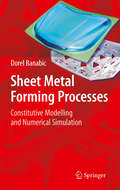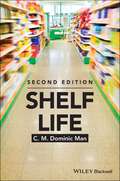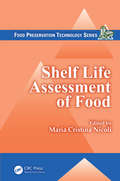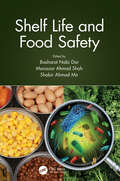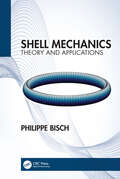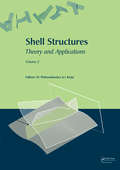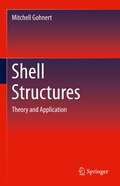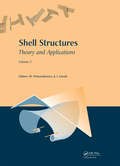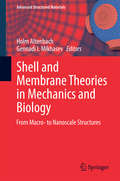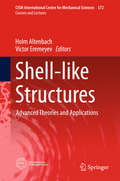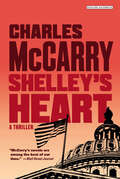- Table View
- List View
Sheet Metal Forming Processes
by Dorel BanabicThe book gives a synthetic presentation of the research performed in the field of sheet metal forming simulation during more than twenty years by the members of three teams: the Research Centre on Sheet Metal Forming - CERTETA (Technical University of Cluj-Napoca, Romania); AUTOFORM software-house company from Zürich, Switzerland and VOLVO automotive company from Sweden. The first chapter reminds some fundamental topics of the theory of plasticity. A more extended chapter is devoted to the presentation of the phenomenological yield criteria, emphasizing the formulations proposed by the CERTETA team (BBC models). The sheet metal formability is discussed in a separate chapter. After presenting the methods used for the formability assessment, the discussion focuses on the forming limit curves. In this context, the authors emphasize their contributions to the mathematical modeling of forming limit curves. The aspects related to the implementation of the constitutive models in finite-element codes are discussed in the last chapter of the book. The performances of the models are proved by the numerical simulation of various sheet metal forming processes: hydroforming, deep-drawing and forming of the complex parts. The book is useful for the students, doctoral fellows, researchers and engineers who are mainly interested in the mechanical modeling and numerical simulation of sheet metal forming processes. Modeling and numerical simulation of sheet metal forming processes.
Sheet Metal Meso- and Microforming and Their Industrial Applications
by Ming Wang Fu Xin Min Lai Lin Fa PengThe book presents a compilation of research on meso/microforming processes, and offers systematic and holistic knowledge for the physical realization of developed processes. It discusses practical applications in fabrication of meso/microscale metallic sheet-metal parts via sheet-metal meso/microforming. In addition, the book provides extensive and informative illustrations, tables, case studies, photos and figures to convey knowledge of sheet-metal meso/microforming for fabrication of meso/microscale sheet-metal products in an illustrated manner. Key Features • Presents complete analysis and discussion of micro sheet metal forming processes • Guides reader across the mechanics, failures, prediction of failures and tooling and prospective applications • Discusses definitions of multi-scaled metal forming, sheet-metal meso/microforming and the challenges in such domains • Includes meso/micro-scaled sheet-metal parts design from a micro-manufacturability perspective, process determination, tooling design, product quality analysis, insurance and control • Covers industrial application and examples
Shelf Life
by Dominic ManShelf life, a term recognised in EU/UK food legislation, may be defined as the period of time for which a food product will remain safe and fit for use, provided that it is kept in defined storage conditions. During this period, the product should retain its desired sensory, chemical, physical, functional and microbiological characteristics, as well as accurately comply with any nutritional information printed on the label. "Shelf life" therefore refers to a number of different aspects; each food product has a microbiological shelf life, a chemical shelf life, and a sensory (or organoleptic) shelf life. These categories reflect the different ways in which a food product will deteriorate over time. Ultimately the shelf life of a food product is intended to reflect the overall effect of these different aspects. Shelf life has always been an important facet of industrial food preparation and production, as food and drink are often produced in one area and then distributed to other areas for retailing and consumption. Globalised distribution and supply chains make it imperative that food should survive the transit between producer and consumer – as a perishable commodity, food carries a high risk of spoilage. As such, a realistic, workable and reproducible shelf life has to be determined every time a new food product is developed and marketed; shelf life determination of food has become an integral part of food safety, quality assurance, product development, marketing, and consumer behaviour. Dominic Man's Shelf Life, now in a revised and updated second edition, encompasses the core considerations about shelf life. Section 1 introduces shelf life, describes its relationship to food safety, and provides answers to the frequently asked questions around shelf life determination and testing which are a manager's chief concerns. Section 2 covers the science of the various ways in which food deteriorates and spoils, including the physical, chemical and microbiological changes. Section 3 looks at shelf life in practice, using case studies of different products to illustrate how shelf life may be determined in real life settings. This book will be invaluable to both practitioners and students in need of a succinct and comprehensive overview of shelf life concerns and topics.
Shelf Life Assessment of Food (Food Preservation Technology)
by Maria Cristina NicoliDetermining accurate shelf life data for foods is essential for assuring food quality and protecting consumers from the effects of degradation. With a proper balance of theory and practical examples, Shelf Life Assessment of Food presents the essential criteria and current methodologies for obtaining accurate and reliable shelf life dating. Definin
Shelf Life and Food Safety
by Basharat Nabi DarThe quality and safety of the food we eat deserves the utmost attention and is a priority for producers and consumers alike. Shelf life studies provide important information to manufacturers and consumers to ensure a high-quality food product. Various evaluation methods are used for shelf life determination and they are usually performed at the manufacturer level. Moreover, various techniques are utilized throughout the food chain that enhance the shelf life of food products.This sensitive issue is reviewed in Shelf Life and Food Safety, which brings together a group of subject experts to present up-to-date and objective discussions on a broad range of topics including food spoilage and safe preservation, packaging, and sensory aspects. The book presents both traditional and innovative technologies for enhancing food safety and increasing shelf life, along with methods for the assessment and prediction of food safety and shelf life.Key Features Overviews the issues associated with shelf life enhancement and shelf life evaluation of various food products Addresses issues important to maintaining food safety Explains how shelf life depends on factors, including ingredients for formulation, processing techniques, packaging, and storage conditions Covers shelf life evaluation methods, determinants for shelf life, food quality assessment, and basic and innovative technologies that will improve the shelf life of food products This book is the first of its kind focusing on issues related to evaluation techniques for shelf life determinants, and techniques for shelf life enhancement. It is appropriate for students, researchers, scientists, and professionals in food science and technology. It is also a helpful source of information for people involved in the food industry, food processing sector, product development, marketing, and other associated fields.
Shell Mechanics: Theory and Applications
by Philippe BischThis book is devoted to shells, a natural or human construction, whose modelling as a structure was particularly developed during the 20th century, leading to current numerical models. Many objects, in industry or civil engineering, come under shell mechanics, so a good knowledge of their behaviour and modelling is essential to master their design. The book highlights the very strong link between the deformation of geometric surfaces and the mechanics of shells. The theory is approached in a general formulation that can apply to any surface, and the applications bring the concepts and the methods of resolution to practical situations. It aims to understand the behaviour of shells and to identify the most important parameters, thus allowing a good interpretation of the numerical results. The reader will be able, with finite element software, to reproduce the proposed solutions. The book is based on the knowledge acquired by the reader in structural mechanics and provides essential information on the geometry of surfaces. It is ideal for students in the fields of engineering using mechanics, as well as professionals wishing to deepen their knowledge of shells.
Shell Structures (Vol. 2): Proceedings of the 9th SSTA Conference, Jurata, Poland, 14-16 October 2009
by Wojciech Pietraszkiewicz Ireneusz KrejaShell Structures. Theory and Applications, Volume 2 contains 77 contributions from over 17 countries, reflecting a wide spectrum of scientific and engineering problems of shell structures. The papers are divided into six broad groups: 1. General lectures; 2. Theoretical modeling; 3. Stability; 4. Dynamics; 5. Numerical analysis; 6. Engineering
Shell Structures: Proceedings of the 11th International Conference "Shell Structures: Theory and Applications, (SSTA 2017), October 11-13, 2017, Gdansk, Poland
by Wojciech Pietraszkiewicz & Wojciech WitkowskiShells are basic structural elements of modern technology and everyday life. Examples of shell structures in technology include automobile bodies, water and oil tanks, pipelines, silos, wind turbine towers, and nanotubes. Nature is full of living shells such as leaves of trees, blooming flowers, seashells, cell membranes or wings of insects. In the human body arteries, the eye shell, the diaphragm, the skin and the pericardium are all shells as well. Shell Structures: Theory and Applications, Volume 4 contains 132 contributions presented at the 11th Conference on Shell Structures: Theory and Applications (Gdansk, Poland, 11-13 October 2017). The papers reflect a wide spectrum of scientific and engineering problems from theoretical modelling through strength, stability and dynamic behaviour, numerical analyses, biomechanic applications up to engineering design of shell structures. Shell Structures: Theory and Applications, Volume 4 will be of interest to academics, researchers, designers and engineers dealing with modelling and analyses of shell structures. It may also provide supplementary reading to graduate students in Civil, Mechanical, Naval and Aerospace Engineering.
Shell Structures: Theory and Application
by Mitchell GohnertThis text provides a complete and thorough derivation of the mathematical theory of shell structures. Many books on shells only give the key equations or snippets of theory, skipping all of the mathematical steps required to solve for the key equations. This is understandable, because of the mathematical complexity of shell structures. Thus, the reader must just accept the design equations blindly, without achieving a complete understanding of shell theory. This book, therefore, fills this gap by providing a complete picture of shell theory. Class tested over three university post-graduate courses and one public course on shell structures, the book is mathematically intensive, but it written in an accessible style ideal for students of engineering mechanics in civil and mechanical engineers concentrations, as well as practicing structural engineers looking for a reference on shells.
Shell Structures: Volume 3
by Wojciech Pietraszkiewicz Jarosław GórskiShells are basic structural elements of modern technology and everyday life. Examples are automobile bodies, water and oil tanks, pipelines, aircraft fuselages, nanotubes, graphene sheets or beer cans. Also nature is full of living shells such as leaves of trees, blooming flowers, seashells, cell membranes, the double helix of DNA or wings of insec
Shell and Membrane Theories in Mechanics and Biology
by Holm Altenbach Gennadi I. MikhasevThis book presents the latest results related to shells characterize and design shells, plates, membranes and other thin-walled structures, a multidisciplinary approach from macro- to nanoscale is required which involves the classical disciplines of mechanical/civil/materials engineering (design, analysis, and properties) and physics/biology/medicine among others. The book contains contributions of a meeting of specialists (mechanical engineers, mathematicians, physicists and others) in such areas as classical and non-classical shell theories. New trends with respect to applications in mechanical, civil and aero-space engineering, as well as in new branches like medicine and biology are presented which demand improvements of the theoretical foundations of these theories and a deeper understanding of the material behavior used in such structures.
Shell and Spatial Structures: Proceedings of IWSS 2023 (Lecture Notes in Civil Engineering #437)
by Francesco Marmo Stefano Gabriele Amedeo Manuello Bertetto Andrea MichelettiThis volume collects the latest advances, innovations, and applications in the field of shell and spatial structures, as presented by leading international researchers at the 2nd Italian Workshop on Shell and Spatial Structures (IWSS), held in Turin, Italy on June 26-28, 2023. The conference was meant to give an overview on experimental and theoretical studies, analysis methods and approaches for the design, computational form finding, structural optimization, manufacturing, testing and maintenance techniques and historical reviews of all types of shell and spatial structures. These include, but are not limited to, tension and membrane structures, framed and lattice structures, gridshells and active-bending structures, shell roofs, tensegrity structures, pneumatic and inflatable structures, active and deployable structures, concrete, metal, masonry, timber and bio-based, spatial structures. The contributions, which were selected by means of a rigorous international peer-review process, present a wealth of exciting ideas that will open novel research directions and foster multidisciplinary collaboration among different specialists.
Shell-like Structures
by Holm Altenbach Victor EremeyevThe book presents mathematical and mechanical aspects of the theory of plates and shells, applications in civil, aero-space and mechanical engineering, as well in other areas. The focus relates to the following problems: * comprehensive review of the most popular theories of plates and shells, * relations between three-dimensional theories and two-dimensional ones, * presentation of recently developed new refined plates and shells theories (for example, the micropolar theory or gradient-type theories), * modeling of coupled effects in shells and plates related to electromagnetic and temperature fields, phase transitions, diffusion, etc. , * applications in modeling of non-classical objects like, for example, nanostructures, * presentation of actual numerical tools based on the finite element approach.
Shelley's Heart: A Thriller
by Charles McCarryA contested presidential election leads to a national crisis in this &“masterful political thriller . . . loaded with intrigue and counter-intrigue&” (Richard Condon, author of The Manchurian Candidate). At the dawn of the twenty-first century, the CIA has been disbanded and a secret society has taken hold of powerful positions across Washington. After a long and contentious campaign, President Bedford Lockwood is celebrating his reelection. But the revelry is cut short when it&’s discovered that his over-zealous aides may have tampered with the vote. On the eve of the Inauguration, Lockwood&’s rival—the archconservative Franklin Mallory—presents evidence of fraud. When Lockwood refuses to take the oath of office, it sets in motion a series of events that may destroy him, his party, and the Constitution. From this catastrophic crisis, acclaimed author and former Washington journalist Charles McCarry weaves a smart, tense, and eerily prescient political thriller.&“Not only exceptionally suspenseful but also unnervingly realistic….gripping and intricate.&” —The Washington Post
Shellfish Aquaculture and the Environment
by Sandra E. ShumwayShellfish Aquaculture and the Environment focuses primarily on the issues surrounding environmental sustainability of shellfish aquaculture. The chapters in this book provide readers with the most current data available on topics such as resource enhancement and habitat restoration. Shellfish Aquaculture and the Environment is also an invaluable resource for those looking to develop and implement environmental best management practices. Edited one of the world's leading shellfish researchers and with contributions from around the world, Shellfish Aquaculture and the Environment is the definitive source of information for this increasingly important topic. View the Executive Summary here: http://seagrant.uconn.edu/publications/aquaculture/execsumm.pdf
Shellfish Processing and Preservation
by Nalan GökoğluShellfish is a broad term that covers various aquatic mollusks, crustaceans and echinoderms that are used as food. They have economic and ecological importance and have been consumed as food for centuries. Shellfish provide high quality protein with all the dietary amino acids essential for maintenance and growth of the human body. Shellfish are a major component of global seafood production, with shellfish aquaculture rapidly growing in recent years. There are many different processing methods used across the world. Shellfish are very perishable foods and must be preserved just after catching or harvesting. This makes the preservation of seafood a critical issue in terms of quality and human health. To date there have been a number of books on seafood processing and preservation, but all of them have been mostly focused on fish. Shellfish Processing and Preservation is the first reference work to focus specifically on shellfish, providing comprehensive coverage of the production methods, biological makeups and preservation methods of all major shellfish species. Individual sections focus on crustaceans such as shrimps and prawns, crabs and lobsters plus molluscans including mussels, scallops and oysters. Cephalopods such as squid and octopus are also covered in depth. For each species processing and preservation methods such as chilling, freezing, canning and curing are examined, plus the important safety aspects specific to each shellfish type. Shellfish Processing and Preservation is an essential publication for any researchers or industry professionals in search of a singular and up-to-date source for the processing and preservation of shellfish.
Shelly Cashman Series Microsoft Office 365 & Excel 2016: Intermediate
by Joy L. Starks Steven M. Freund Eric SchmiederDiscover the latest advancements in Microsoft Excel 2016 with MICROSOFT OFFICE 365 & EXCEL 2016: INTERMEDIATE -- the new edition in today’s generation of acclaimed Shelly Cashman Series books. For more than three decades, the Shelly Cashman Series has effectively introduced computer skills to millions. MICROSOFT OFFICE 365 & EXCEL 2016: INTERMEDIATE continues the Series’ strong history of innovation with a proven learning approach enhanced to address the learning styles of students like you. A trademark step-by-step, screen-by-screen approach encourages you to expand your understanding of Microsoft Excel 2016 through experimentation, critical thought, and personalization. This new edition delivers effective educational materials specifically designed to engage, improve retention, and prepare you for future success in working with both basic and more advanced Microsoft Excel 2106 skills.
Shepard Takes Charge
by Philip W. OgilvieMove America's capital to another city? To Alexander Robey Shepherd, the solution to Washington, DC's problems was clear: modernization. Shepherd took on the monumental task of improving roadways and drinking water, adding street gaslights, and planting trees.
Shepherding UxVs for Human-Swarm Teaming: An Artificial Intelligence Approach to Unmanned X Vehicles (Unmanned System Technologies)
by Hussein A. Abbass Robert A. HunjetThis book draws inspiration from natural shepherding, whereby a farmer utilizes sheepdogs to herd sheep, to inspire a scalable and inherently human friendly approach to swarm control. The book discusses advanced artificial intelligence (AI) approaches needed to design smart robotic shepherding agents capable of controlling biological swarms or robotic swarms of unmanned vehicles. These smart shepherding agents are described with the techniques applicable to the control of Unmanned X Vehicles (UxVs) including air (unmanned aerial vehicles or UAVs), ground (unmanned ground vehicles or UGVs), underwater (unmanned underwater vehicles or UUVs), and on the surface of water (unmanned surface vehicles or USVs). This book proposes how smart ‘shepherds’ could be designed and used to guide a swarm of UxVs to achieve a goal while ameliorating typical communication bandwidth issues that arise in the control of multi agent systems. The book covers a wide range of topics ranging from the design of deep reinforcement learning models for shepherding a swarm, transparency in swarm guidance, and ontology-guided learning, to the design of smart swarm guidance methods for shepherding with UGVs and UAVs. The book extends the discussion to human-swarm teaming by looking into the real-time analysis of human data during human-swarm interaction, the concept of trust for human-swarm teaming, and the design of activity recognition systems for shepherding.Presents a comprehensive look at human-swarm teaming;Tackles artificial intelligence techniques for swarm guidance;Provides artificial intelligence techniques for real-time human performance analysis.
She’s In CTRL: How women can take back tech – to communicate, investigate, problem-solve, broker deals and protect themselves in a digital world
by Anne-Marie Imafidon'A practical and positive guide to using tech to change women's lives for the better' -Caroline Criado Perez, author of Invisible Women: exposing data bias in a world designed for men'A powerful and inspiring call to action from one of Britain's brightest minds'- Yomi Adegoke, award-winning journalist, author of Slay in Your Lane etc.Why are women so under-represented in the tech world?Why does this matter?What can we do about it? A book that asks essential questions and provides long-overdue practical solutions. Perfect for readers of Invisible Women.Why do so many of us - particularly women - feel the tech world is beyond reach? Women are woefully under-represented in tech - they represent roughly a mere quarter of the UK STEM workforce. This means an ever-increasing series of big decisions are made by a small number of people, mainly men.So what are the challenges for all of us who want to wrest back control? How do we get past the gatekeepers? When we do, what are the opportunities that will open up - for us in our individual roles, and for the future of tech?.Dr Imafidon shows we have more agency than we think, drawing on her own experience and the stories of other pioneers and innovators to provide examples, exercises and practical guidance for how to get started and take control.There will always be problems. But, as we know, women are problem-solvers.
Shh! Bears Sleeping
by David MartinIn the fall When leaves turn red Bears know soon It&’s time for bed Comes winter Comes snow Bears are ready Bears go In their cave Warm and deep Winter is time For bears to sleep A lilting read-aloud text and stunning pictures combine to make an irresistibly appealing picture book that follows these fascinating animal friends through the cycle of the year. A page of facts about bears will answer young readers' questions as they begin to explore the wonders of the natural world.
Shield Tunnel Cutter Replacement Technology (Key Technologies for Tunnel Construction under Complex Geological and Environmental Conditions)
by Jian Chen Fanlu MinThis book proposes the tool change methods for the excessive tool wear in the construction rules of shield tunnel construction in China. From the perspective of shield tunneling, atmospheric pressure tool change, pressure opening and tool change, and other special techniques, the tool change technologies are proposed. It highlights a number of tool-changing techniques and research and development work, including pressure-changing tools, tool-changing tools in the tool-cylinder arm, and cutter-tooth cutter inter-change since the beginning of the construction of the Nanjing Yangtze River Tunnel.
Shield Tunneling Technology in Hard-Soft Uneven Stratum and Extremely-Soft Stratum (Key Technologies for Tunnel Construction under Complex Geological and Environmental Conditions)
by Kairong HongThis book focuses on some technical problems encountered in shield tunneling in hard–soft uneven stratum and extremely soft stratum, based on the recent shield tunneling engineering practice, and summarizes the achievements of shield tunneling in view of the technical problems from an overall and objective perspective. There are 6 chapters in this book. Chapter 1 introduces the development trend of shield tunneling method, defines classification of various stratum where shield tunneling applies, and mainly analyses the selection of shield machines and the configuration of cutters. Chapters 2 to 5 elaborates the strata characteristics and construction difficulties under various stratum conditions, puts forward adaptive selection and design keys of shield in various stratum, and emphatically analyses and summarizes the stability control technologies of shield tunnel face and driving control technology by case studies. Chapter 6 introduces the shield chamber opening technologies under hyperbaric condition, emphatically presents the basic requirements and operational preparations for the shield chamber opening, and puts forward innovative ideas of operation procedures, control points of key procedures, and safety requirements of shield chamber opening under hyperbaric condition.
Shield Tunneling Technology in Mixed Face Ground Conditions
by Hui Wang Weibin Zhu Shijian JuThis book introduces shield construction risks under mixed face ground condition, analyzes the shield tunneling risks, gives definitions of relevant risks and creates the theoretical system of shield tunneling technology under mixed face ground condition, that is, geology is the foundation, TBM is the key, and people (management) is the essence. The content provides numbers of targeted solutions, such as dual-mode TBM, multi-mode TBM, millisecond delay blasting for boulders, Paste HDN, auxiliary pressure balance tunneling and so on. This book can make researchers who engaged in shield tunneling to get experiences and lessons from it, so as to make the right decision during shield type selection, standardize shield tunneling, take proper action, avoid or reduce construction risks, and minimize casualties and property losses.
Shielded Metal Arc Welding Basic
by Hobart Institute of Welding TechnologyA STEP-BY-STEP METHOD FOR ACQUIRING BASIC SKILLS IN SHIELDED METAL ARC WELDING
